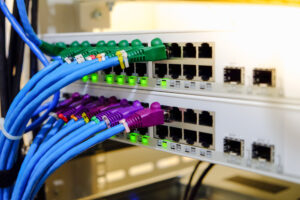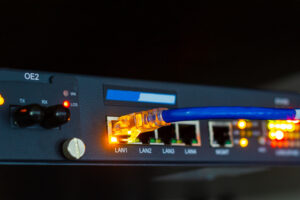Network
Architecture
Design &
Consultation
Network design sits at the heart of any modern business and the design of your network and systems can greatly impact your business. Various best practices can increase the performance and security of your network infrastructure, increasing productivity and reducing downtime.

What is Network Architecture Design?
Network architecture refers to the design and structure of a computer network — it includes hardware and software components, protocols, and communication technologies. Both small local area networks (LAN) and sizable wide area networks (WAN) rely on network architecture to organize infrastructure securely.
Here are some highlighted considerations that should be made when identifying if your network architecture is sufficient.
Edge Security
Edge security refers to the protection of data, devices and networks at the “edge” of a distributed computing environment, where data is processed closer to the source or user instead of in a centralised data centre. This approach is increasingly important due to the rise of IoT devices, remote work and mobile applications, enhancing response times and reducing latency.
Key components of Edge security include:
- Data Encryption
Securing data in transit and at rest to prevent unauthorised access - Identity & Access Management
Ensuring that only authorised users and devices access Edge resources through robust authentication mechanisms - Threat Detection and Response
Implementing real-time monitoring and analytics to quickly identify and respond to potential threats - Network Security
Protecting communication between Edge devices and Cloud or data centres with firewalls and VPNs
Given its distributed nature, Edge security is complex. It requires a coordinated strategy to mitigate vulnerabilities while maintaining performance. Effective edge security is essential for safeguarding sensitive information and ensuring reliable services in an increasingly interconnected world. Some of the information we offer to assist with Edge Security can be found on the following pages: Antivirus, Sophos UTM, a Managed Firewall and SpamTitan, a product from TitanHQ that covers email security.
Intra-site/Local Area Network (LAN)
LANs are characterized by high data transfer speeds and low latency, making them ideal for tasks that require quick communication between devices, such as video conferencing and data sharing. They are commonly set up using a combination of routers, network switches, and access points to manage data traffic and enhance network performance.
- Network Switches
- Wireless Access Points
- Routers
This refers to the core devices that are used to provide a communication layer through cabling on a computer network (can be Layer 2, 3 or a combination of both on an OSI Model). With smaller companies you may see only one network switch, whereas bigger companies may have multiple, daisy-chained together or spread-out through a building.

A device which allows access to a local area network through wireless protocols. This can be access to the company network, or a segregated ‘Guest’ network. When in use, multiple Intelligent Access Points (AP’s) should be controlled through software to allow for best connection, preventing duplicate WiFi connections and overlapping signals. One of the best products we have used is the UniFi series from Ubiquiti.

Used for the connection of two (or more) packet-switched networks. The most common use for this is connecting the internet which is received from a third party to the local area network, providing interest access for the business. Modern consumer based routers have a lot of functionality built-in for home requirements, such as pre-set DNS servers and WiFi capabilities. As such, these are not necessarily suitable for businesses which require tighter security control and management.

Security is essential in LANs as unauthorised access can compromise sensitive information. Common security measures include password protection, firewalls, and network segmentation. LANs can also be extended using Virtual LANs (VLANs), allowing for better management and isolation of network traffic. Overall, LANs are fundamental to modern computing environments, providing an efficient way to connect and communicate devices within close proximity.
Servers
In network architecture, servers play a critical role as they provide essential services to client machines, including web hosting, file storage, database management, and application support. Typically categorized as application servers, web servers, or database servers, these devices can be deployed physically or virtually.
A server operates using a client-server model where clients request resources or services, and servers fulfil those requests. Scalability, reliability, and security are key considerations in server design, ensuring they can handle varying workloads and protect sensitive data.
Servers may be organised in data centres and use various configurations such as rack-mounted, blade or tower setups, offering different levels of performance and space efficiency. Virtualisation technologies allow multiple virtual servers to run on a single physical machine, optimising resource utilisation. Overall, servers are foundational components of modern network architecture, enabling efficient communication and resource sharing within and across organisations. For more technical information, as well as an example server and storage build, please take a look at our SME IT Infrastructure page.
Inter-site/Wide Area Network (WAN)
This refers to the networking architecture that connects multiple geographically dispersed locations, such as branch offices or data centres. This architecture is crucial for businesses that operate in multiple regions and require seamless communication and data exchange across sites.
WANs utilise various technologies including leased lines, MPLS (Multiprotocol Label Switching), VPNs (Virtual Private Networks) and the internet to ensure connectivity. They can support various protocols and services, enabling real-time applications like VoIP and video conferencing.
Key considerations for inter-site/WAN architecture include bandwidth, latency, reliability, and security. As organisations increasingly adopt Cloud computing and remote work, optimising WAN performance becomes essential. Advanced solutions like SD-WAN (Software-Defined WAN) enhance flexibility by enabling centralised control, intelligent traffic management and better application performance across diverse environments.
